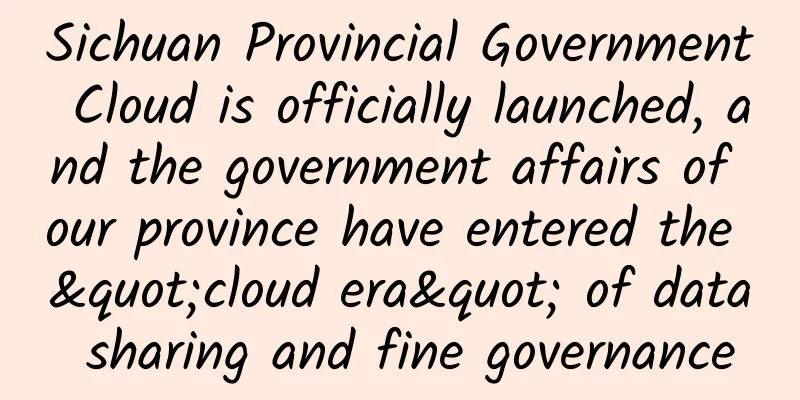Sichuan Provincial Government Cloud is officially launched, and the government affairs of our province have entered the "cloud era" of data sharing and fine governance

|
Provincial government advisor Zhang Zuoha and secretary-general Luo Qiang attended the launching ceremony. When the masses need to do things, they have to prove that "your mother is your mother"; after receiving the minimum living allowance for several years, they are the boss of a BMW. Farces frequently occur because it is difficult for government departments to share data and collaborate on business. On January 20, the Sichuan Provincial Government Cloud was officially launched in Chengdu, representing that Sichuan's government affairs have entered the "cloud era" of data sharing and fine governance, laying the foundation for ending similar farces. The Sichuan provincial government cloud is built based on the "1+N+N+1" model, that is, one cloud supervision platform, multiple cloud service provider platforms, multiple department integration platforms, and one cloud disaster recovery platform, which resolves supervision problems from the system architecture and ensures service quality from the system construction. At present, the Sichuan provincial government cloud has identified a cloud supervision platform supplier (China Electronics Technology Network Information Security Co., Ltd.) and two cloud service suppliers (China Mobile + H3C Communications Consortium, China Telecom + Tencent Consortium), and integrated the construction to complete the "1+N+N+1" prototype. The provincial government cloud has functions including cloud host, cloud storage, cloud firewall, cloud load balancing, cloud database, cloud audit, cloud application, etc., and can provide Gigabit high-speed Internet access interface for provincial departments and public users. At present, 13 provincial departments and 27 applications have been migrated to the cloud platform for operation. For government work, the construction of provincial government cloud reduces duplicate investment and effectively avoids waste. In recent years, the construction of provincial government informationization in Sichuan has some obvious problems such as duplicate construction, low utilization rate, and idle equipment. According to incomplete statistics, the investment in provincial e-government projects approved for construction from 2011 to 2014 exceeded 600 million yuan. In recent years, the provincial finance has allocated nearly 500 million yuan for information system operation and maintenance every year, and the provincial department information construction and maintenance team has more than 1,000 people. Time costs can also be greatly saved. In the past, an informationization project took 2-3 years to complete. Now, you only need to apply on the government cloud platform, and the above work can be completed in 5 minutes to build an information system. For the public, the provincial government cloud provides strong support for government services for the public in various departments, making it more convenient in terms of efficiency and Internet services. At present, when the public is doing business, the government's internal information system often has problems such as long waiting time and inability to log in. The reasons behind this are that the information system's carrying equipment is aging, the large number of users leads to insufficient support resources, and the information technology update cannot keep up with the development. Now, through the cloud platform, we can concentrate superior resources to meet the needs of application changes, reasonably allocate resources to meet peak demands, and provide a faster network interface for easy use, which is equivalent to a highway with 20 lanes before, but each department has 1 lane, and now they are concentrated together for co-construction and sharing. Next, the government cloud will continue to be vigorously promoted. Starting from 2016, the construction of the cloud disaster recovery platform will be launched, and at the same time, the construction demonstration of the department cloud integration platform will be carried out. The department data centers and computer rooms with good basic conditions will be integrated and incorporated into the provincial government cloud platform for unified management and overall utilization. Explore the provision of services to cities (prefectures) to give full play to the greater intensive benefits of the government cloud. The non-confidential information systems of provincial government departments will be migrated to the provincial government cloud platform in batches and phases before 2018, and the provincial government departments will complete it first before June 2017. Starting from 2016, departments will no longer build new computer rooms, data centers, or purchase hardware equipment. |
>>: Huawei and Yingke jointly launch the petrochemical smart factory 2.0 construction platform
Recommend
5G private network spectrum allocation controversy: not black and white, but efficiency first
Recently, the French government announced that in...
What are the short-range wireless communication technologies?
Wireless communication technology has taken off i...
Wireless Technology Review in 2016: 3.5 GHz Prompts New Changes in Spectrum Sharing
According to foreign media reports, in the past y...
Digital transformation has led to a surge in the number of emerging application services
January 17, 2018? F5 Networks (NASDAQ: FFIV) toda...
Chrome downloads are so annoying! Here's how to fix it
Chrome is the most popular web browser in the wor...
Ruijie Networks 2019 Partner Conference held: Join hands with partners to seek growth and work together to soar
On March 6, the Ruijie Networks 2019 Partner Conf...
Controlling the throat of the Internet of Things, what value can wireless communication technology bring to the application field?
Communication technology has been the most talked...
Wi-Fi 6 Column | Is Wi-Fi 6 omnipotent?
Wireless networks have been around for a long tim...
Please! Stop asking me these questions about multithreading
[[340332]] This article is reprinted from the WeC...
What are the future trends of mobile phone connections?
Over the next decade, the number of connected end...
The love-hate relationship between Bluetooth 5 and WiFi
It can be said that Bluetooth and Wi-Fi each have...
LOCVPS: VPS in the United States/Netherlands/Germany/Australia 40% off, starting at 22 yuan/month, Hong Kong/Korea/Japan 20% off
LOCVPS has launched a February New Year promotion...
This year's 5G mobile phones must have these features!
[[387087]] This article is reprinted from the WeC...
The battle for 5G dominance between China and the United States: No one can retreat!
According to US media, the early wave of mobile c...









